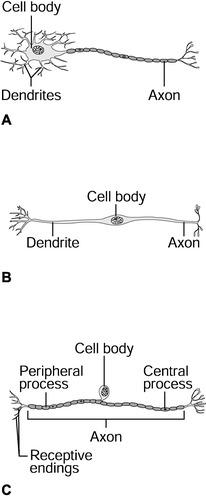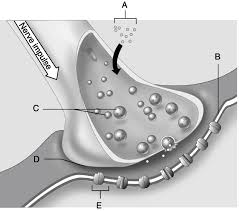
1.) Which neuron would connect to a muscle?
2.) Which neuron would be found in the retina of the eye?
3.)Which neuron is a sensory neuron found in a reflex arc?
4.)Which neuron is never myelinated?
1.) A
2.) B
3.) C
4.) B

1.) Which neuron is rare?
2.) In a reflex arc, which neuron has its cell body inside the spinal cord?
3.) Which neuron is common only in dorsal root ganglia of the spinal cord and sensory ganglia of cranial nerves?
4.) Which is by far the most common neuron type?
1.) B
2.) A
3.) C
4.) A
True or false: The all-or-none phenomenon as applied to nerve conduction states that the whole nerve cell must be stimulated for conduction to take place.
False
1.) One incoming fiber triggers responses in ever-increasing numbers farther and farther along the circuit.
2.) May be involved in complex, exacting types of mental processing.
3.) Involved in control of rhythmic activities such as breathing.
4.) Involved in activating fibers of a skeletal muscle such as
the biceps muscle.
5) Different types of sensory input can have
the same ultimate effect.
A) Reverberating circuit
B) Diverging circuit
C) Parallel
after-discharge circuit
D) Converging circuit
1.)B
2.)C
3.)A
4.)B
5.)D
True or False:
Cell bodies of sensory neurons may be located in ganglia lying outside the central nervous system
True
True or False:
Myelination of the nerve fibers in the central nervous system is the job of the oligodendrocyte
True
Which of the following is not a function of astrocytes?
A) provide the defense for the CNS
B) support and brace neurons
C) control the chemical environment around neurons
D) guide the migration of young neurons, synapse formation, and helping to determine capillary permeability
E) anchor neurons to blood vessels
A.
Which of the following is not a chemical class of neurotransmitters? A) biogenic amine
B) amino acid
C) nucleic acid
D) ATP and other purines
E) acetycholine
C.
What does the central nervous system use to determine the strength of a stimulus?
A) size of action potentials
B) frequency of action potentials
C) origin of the stimulus
D) type of stimulus receptor
B.
Select the correct statement regarding synapses.
A) The release of neurotransmitter molecules gives cells the property of being electrically coupled.
B) Neurotransmitter receptors are located on the axons terminals of cells.
C) The synaptic cleft prevents an impulse from being transmitted directly from one neuron to another.
D) Cells with gap junctions use chemical synapses
C.
The period after an initial stimulus when a neuron is not sensitive
to another stimulus is the ________.
A) depolarization
B) absolute refractory period
C) repolarization
D) resting period
B.
True or False :
Strong stimuli cause the amplitude of action potentials generated to increase
False

1.) Ion channel.
2.) Synaptic vesicles.
3.) Calcium ions.
4.) Postsynaptic membrane.
5.) Synaptic cleft.
1.) E
2.) C
3.) A
4.) B
5.) D
Neuroglia that control the chemical environment around neurons by
buffering potassium and recapturing neurotransmitters are
________.
A) astrocytes B) microglia C) Schwann cells D) oligodendrocytes
A.
Schwann cells are functionally similar to ________.
A) microglia B) astrocytes C) oligodendrocytes D) ependymal cells
C.
True or false:
Enkephalins and endorphins are peptides that act like morphine
True
Which ion channel opens in response to a change in membrane potential
and participates in the generation and conduction of action
potentials?
A) ligand-gated channel
B) leakage channel
C) voltage-gated channel
D) mechanically gated channel
C.
1.)Area where nerve impulse is generated.
2.) Receives stimuli.
3.) Plasma membrane exhibits voltage-gated Na+ and K+ channels.
4.) Plasma membrane exhibits voltage-gated Ca2+ channels.
5.) Axon terminals release neurotransmitters.
6.) Plasma
membrane exhibits chemically gated ion channels.
A) Conducting region
B) Receptive region
C) Secretory
zone
D) Secretory region
E) Trigger zone
1.)E
2.) B
3.)A
4.)D
5.)C
6.)B
Nerve cell adhesion molecules (N-CAMs) ________.
A) release nerve growth factor
B) are crucial in the production of neurotransmitters
C) are crucial for the development of neural connections
D) are found on "pathfinder" neurons
C.
What is the role of acetylcholinesterase?
A) act as a transmitting agent
B) stimulate the production of acetylcholine
C) destroy ACh a brief period after its release by the axon endings
D) amplify or enhance the effect of ACh
C.
Collections of nerve cell bodies outside the central nervous system are called ________.
A) ganglia B) nerves C) nuclei D) tracts
A.
An inhibitory postsynaptic potential (IPSP) is associated with ________. A) lowering the threshold for an action potential to occur
B) opening of voltage-regulated channels
C) a change in sodium ion permeability
D) hyperpolarization
D.
The term central nervous system refers to the ________.
A) peripheral and spinal nerves
B) brain and spinal cord
C) brain, spinal cord, and peripheral nerves
D) spinal cord and spinal nerves
B.
Which of the following neurotransmitters inhibits pain and is
mimicked by morphine, heroin, and methadone?
A) acetylcholine B)
serotonin C) nitric oxide D) endorphin
D.
A neuron that has as its primary function the job of connecting other
neurons is called a(n) ________.
A) afferent neuron
B) glial cell
C) efferent neuron
D) association neuron
D.
True or False:
In myelinated axons the voltage-regulated sodium channels are concentrated at the nodes of Ranvier
True
Saltatory conduction is made possible by ________.
A) erratic transmission of nerve impulses
B) the myelin sheath
C) large nerve fibers
D) diphasic impulses
B.
Which of the following will occur when an excitatory postsynaptic
potential (EPSP) is being generated on the dendritic membrane?
A)
A single type of channel will open, permitting simultaneous flow of
sodium and potassium.
B) Sodium gates will open first, then close as potassium gates open. C) Specific sodium gates will open.
D) Specific potassium gates will open.
A.
When a sensory neuron is excited by some form of energy, the
resulting graded potential is called a(n) ________.
A) excitatory potential
B) generator potential
C) postsynaptic potential
D) action potential
B.
1.) Numerous nerve impulses arriving at a synapse at closely timed
intervals exert a cumulative effect.
2.) Stimulation of a
postsynaptic neuron by many terminals at the same time.
3.) An
insufficient stimulus.
4.) Any stimulus below this intensity
will result in no response in a neuron.
A) Subthreshold stimulus
B) Temporal summation
C) Spatial
summation
D) Threshold stimulus
1.)B
2.)C
3.) A
4.)D
True or False:
The nodes of Ranvier are found only on myelinated, peripheral neuron processes
False
Which of the following is not true of graded potentials?
A) They increase amplitude as they move away from the stimulus point.
B) They can form on receptor endings.
C) They can be called postsynaptic potentials.
D) They are short-lived.
A.
A second nerve impulse cannot be generated until ________.
A) proteins have been resynthesized
B) the membrane potential has been reestablished
C) the Na ions have been pumped back into the cell
D) all sodium gates are closed
B.
In what way does the interior surface of a cell membrane of a resting
(nonconducting) neuron differ from the external environment? The
interior is ________.
A) negatively charged and contains less sodium
B) positively charged and contains less sodium
C) negatively charged and contains more sodium
D) positively charged and contains more sodium
A.
If a motor neuron in the body were stimulated by an electrode placed
about midpoint along the length of the axon ________.
A) the
impulse would move to the axon terminal only
B) muscle contraction would occur
C) the impulse would move to the axon terminal only, and the muscle contraction would occur
D) the impulse would spread bidirectionally
D.
True or False:
A stimulus traveling toward a synapse appears to open calcium ion channels at the presynaptic end, which in turn promotes fusion of synaptic vesicles to the axonal membrane.
True
True or False:
Unipolar neurons have axons structurally divided into peripheral and central processes.
True
True or False:
Strong stimuli cause the amplitude of action potentials generated to increase.
False
True or False:
Axon diameter and degree of myelination determine nerve impulse conduction velocity
True
True or False:
Axon diameter and degree of myelination determine nerve impulse conduction velocity
True